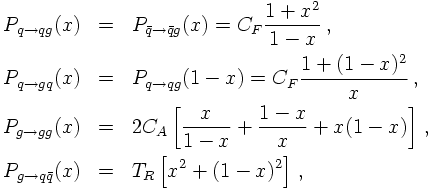QCD
Multiple gluon/parton radiation
- e+e-→ hadrons at higher orders
- Jets
- Large logarithms and splitting functions
IDENTIFYING LARGE LOGS
Let us now try to analyse the logarithmic structure of the gluon emission process in
some more detail. In order to do so, consider the differential cross section for producing a
quark with fractional energy x in the qqg final state. It reads
 Here, clearly the first integral diverges logarithmically for z→ 1, but the second one is finite
for all values of z. Anyways, without going into any detail considering the divergent z-integral,
it is also obvious that this differential cross section diverges for x→ 1. However, from
the previous discussion it is known that the inclusion of the virtual contribution will render the
total result finite:
Here, clearly the first integral diverges logarithmically for z→ 1, but the second one is finite
for all values of z. Anyways, without going into any detail considering the divergent z-integral,
it is also obvious that this differential cross section diverges for x→ 1. However, from
the previous discussion it is known that the inclusion of the virtual contribution will render the
total result finite:
 or, written in a more catchy way
or, written in a more catchy way
 This allows to define specific distributions, also known as "+"-functions, which in this
case boils down to including the virtual pieces into the differential cross section. These
function in general are defined as
This allows to define specific distributions, also known as "+"-functions, which in this
case boils down to including the virtual pieces into the differential cross section. These
function in general are defined as
 Keeping this in mind, it is clear that the differential cross section above can be written
as
Keeping this in mind, it is clear that the differential cross section above can be written
as
 where
where
 and
and
 according to the definition above. From the consideration so far, it is easy to construct the
differential +-function. It reads
according to the definition above. From the consideration so far, it is easy to construct the
differential +-function. It reads
 where L denotes the logarithmically divergent piece (the z-integration) and f(L) is the
remnant function, depending on how the z integral was regularised.
where L denotes the logarithmically divergent piece (the z-integration) and f(L) is the
remnant function, depending on how the z integral was regularised.
SPLITTING FUNCTIONS
However, here P(x) is the splitting function related to the splitting of a quark into a quark
and a gluon. It reads
 Of course, in fact it is also a "+"-distribution. Again, due to this, its integral over
the interval from 0 to 1 vanishes identically. However, in the following this property of
splitting functions to be in fact distributions will be ignored. Here it suffices to
state that the splitting function carries the essential logarithmically enhanced pieces
of a radiation process in such a way that subsequent emissions can be described by
sequences of splitting functions. Of course, there are more splitting functions. They
read
Of course, in fact it is also a "+"-distribution. Again, due to this, its integral over
the interval from 0 to 1 vanishes identically. However, in the following this property of
splitting functions to be in fact distributions will be ignored. Here it suffices to
state that the splitting function carries the essential logarithmically enhanced pieces
of a radiation process in such a way that subsequent emissions can be described by
sequences of splitting functions. Of course, there are more splitting functions. They
read
 where
where
 are the structure constants of QCD.
are the structure constants of QCD.
- Resummation/exponentiation
- DIS: Deep inelastic scattering and the DGLAP evolution equation
- Drell-Yan processes at hadron colliders










